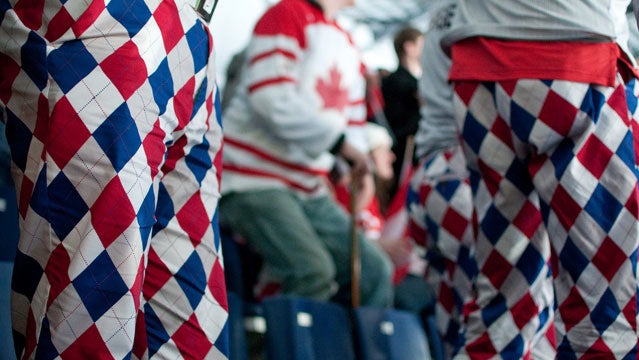You shouldn’t do anything because of a pair of pants, but curling is boring. At least, in a mainstream-sport, easy-to-excite sense, it is. There’s no one moving fast or jumping high or tackling anyone. It’s just one guy sliding on some ice and two other guys furiously sweeping a broom. Stones move toward an iced-over target, and whatever team is closer to the center gets the points. When you can’t really grasp what’s going on, it’s basically watching a game of tic tac toe.
The Coldest Stone
Welcome to CurlingIt’s definitely more complex than that because otherwise everyone would be in contention for a spot in the Olympics, but the camera angles don’t really do much justice to the delicate and slight movements the stone makes, and coming from the outside, all the complexities get stripped away. (YouTube announcers at a continental, niche-sporting event tend not to cater to beginners, either.) One guy slides a stone down the ice. Then, so does his opponent. It keeps happening, eventually the points go a certain way, and then a group of guys wearing scary pants win.
At least, that’s been the story of the European Curling Championships so far. They’re happening as I write this. It’s live on YouTube, and as jaypek94 said, “Hard to believe there are only 97 people watching this!” To jaypek94, I’d posit that there are actually 90-something families huddled around computers, skipping work and generally letting the foundations of their lives crumble just to watch curling, which brings that number closer to 270. I mean, free curling! (It’s actually not bad background sound, a white-ish noise of unintelligible Nordic and Eastern European screaming, brushes scraping ice, and occasionally-clanking rocks.) But if only 97 people are seeing on a consistent basis, then it’s kind of sad.
The typical curling uniform consists of some kind of short-sleeve shirt, black trousers, and black shoes. Norway’s pants, though, are an extended, repeating Norwegian flag that kind of looks like a windowpane covered in the blood of their competitors because Norway does not mess around on the ice. Dudes are vicious. They’re 6-1, tied for first with Sweden, losing their one match to whose best curler was “Struggling with my confidence a wee bit. Struggling with ice a wee bit.”
If you stare at these pants for long enough, you will die—because, if you do anything for long enough, you will die. A flag is a symbol, though, a normally rectangular thing that is what it is: a flag. It’s a design on a constant-size rectangular fabric—beginning and ending there. But flag-pants are something certainly more sinister because how many flags actually are there here? There’s an infinite number if you really think about it, and well, contemplate infinity for too long and you will cease to exist.
Beyond generally rendering human life to be pointless, flag-pants do two things. They rep’ a country, but they also commodify an entire nation as a way to keep warm, to not be naked, and to say something about yourself. Because, most of the time, the pants you wear say something about you. They’re on your legs for one reason or another. (We already know these guys are Norweigan, so it goes beyond wanting to be identified correctly.) In that these pants are uniforms, though, someone on Norway’s team probably begrudgingly puts them on one leg at a time—curlers are just like us, guys—wondering what’s wrong with everyone else’s black pants. But someone, at some point in the history of the world, thought these pants would be a good idea.
(Norway has .)
After a win over Denmark on Sunday, Norway’s team leader and lead curler, Thomas Ulsrud, . “The only problem is I’m feeling better now,” Ulsrud said, “but I’m playing not that good. Yesterday, I was feeling shit and playing good. So now it’s the opposite.
It’s a reminder of the fleeting nature of the human condition, but more generally a reminder that we are all human. We do everything we do—like watch curling, wear stupid legwear, or watch curling in order to see stupid legwear—for reasons, however specific, nebulous, and unable-to-be-articulated they are. And still, things happen that we can’t control. Living a life is a contradiction mirrored by a volatile curling performance. Things happen because we want them to, but they also happen, more often than they don’t, outside of our volition. Today, you put on your pants because you wanted to—and that lets you know you’re alive. Yet, the first time you don’t put on your own pants is the last time you’ll ever get dressed.


